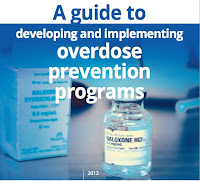Community-Based Opioid Overdose Prevention Programs Providing Naloxone — United States, 2010
Weekly
February 17, 2012 / 61(06);101-105Drug overdose death rates have increased steadily in the United States since 1979. In 2008, a total of 36,450 drug overdose deaths (i.e., unintentional, intentional [suicide or homicide], or undetermined intent) were reported, with prescription opioid analgesics (e.g., oxycodone, hydrocodone, and methadone), cocaine, and heroin the drugs most commonly involved (1). Since the mid-1990s, community-based programs have offered opioid overdose prevention services to persons who use drugs, their families and friends, and service providers. Since 1996, an increasing number of these programs have provided the opioid antagonist naloxone hydrochloride, the treatment of choice to reverse the potentially fatal respiratory depression caused by overdose of heroin and other opioids (2). Naloxone has no effect on non-opioid overdoses (e.g., cocaine, benzodiazepines, or alcohol) (3). In October 2010, the Harm Reduction Coalition, a national advocacy and capacity-building organization, surveyed 50 programs known to distribute naloxone in the United States, to collect data on local program locations, naloxone distribution, and overdose reversals. This report summarizes the findings for the 48 programs that completed the survey and the 188 local programs represented by the responses. Since the first opioid overdose prevention program began distributing naloxone in 1996, the respondent programs reported training and distributing naloxone to 53,032 persons and receiving reports of 10,171 overdose reversals. Providing opioid overdose education and naloxone to persons who use drugs and to persons who might be present at an opioid overdose can help reduce opioid overdose mortality, a rapidly growing public health concern.
Overdose is common among persons who use opioids, including heroin users. In a 2002–2004 study of 329 drug users, 82% said they had used heroin, 64.6% had witnessed a drug overdose, and 34.6% had experienced an unintentional drug overdose (4). In 1996, community-based programs began offering naloxone and other opioid overdose prevention services to persons who use drugs, their families and friends, and service providers (e.g., health-care providers, homeless shelters, and substance abuse treatment programs). These services include education regarding overdose risk factors, recognition of signs of opioid overdose, appropriate responses to an overdose, and administration of naloxone.
To identify local program locations and assess the extent of naloxone distribution, in October 2010 the Harm Reduction Coalition e-mailed an online survey to staff members at the 50 programs then known to distribute naloxone. Follow-up e-mails and telephone calls were used to encourage participation, clarify responses, and obtain information on local, community-based programs. The survey included questions about the year the program began distributing naloxone, the number of persons trained in overdose prevention and naloxone administration, the number of overdose reversals reported, and whether the totals were estimates or based on program data. The survey also asked questions regarding the naloxone formulations currently distributed, any recent difficulties in obtaining naloxone, and the program's experience with naloxone distribution.
Staff members at 48 (96%) of the 50 programs completed the online survey. Since the first program began distributing naloxone in 1996, through June 2010, the 48 responding programs reported providing training and distributing naloxone to an estimated 53,032 persons (program range: zero to 16,220; median: 102.5; mean: 1,104.8).* From the first naloxone distribution in 1996 through June 2010, the programs received reports of 10,171 overdose reversals using naloxone (range: zero to 2,385; median: 32; mean: 211.9).† During a recent 12-month period, respondents distributed an estimated 38,860 naloxone vials (Table).§ Using data from the survey, the number of programs beginning naloxone distribution each year during 1996–2010 was compared with the annual crude rates of unintentional drug overdose deaths per 100,000 population from 1979 to 2008 (Figure 1) (1).
The 48 responding programs were located in 15 states and the District of Columbia. Four responding programs provided consolidated data for multiple local, community-based programs. Three state health departments, in New York, New Mexico, and Massachusetts, provided data for 129 local programs (65, 56, and eight, respectively); a nongovernmental organization in Wisconsin provided data on a statewide operation with 16 local programs. In all, the 48 responding programs provided data for 188 local opioid overdose prevention programs that distributed naloxone (Figure 2). Nineteen (76.0%) of the 25 states with 2008 drug overdose death rates higher than the median and nine (69.2%) of the 13 states in the highest quartile (1) did not have a community-based opioid overdose prevention program that distributed naloxone (Figure 2).
For a recent 12-month period, the 48 responding programs reported distributing 38,860 naloxone vials, including refills (range: zero to 12,070; median: 97; mean: 809.6).¶ Overdose prevention programs were characterized as small, medium, large, or very large, based on the number of naloxone vials distributed during that period. The six responding programs in the large and very large categories distributed 32,812 (84.4%) of the naloxone vials (Table).
Twenty-one (43.7%) responding programs reported problems obtaining naloxone in the "past few months" before the survey. The most frequently reported reasons for difficulties obtaining naloxone were the cost of naloxone relative to available funding and the inability of suppliers to fill orders.**
